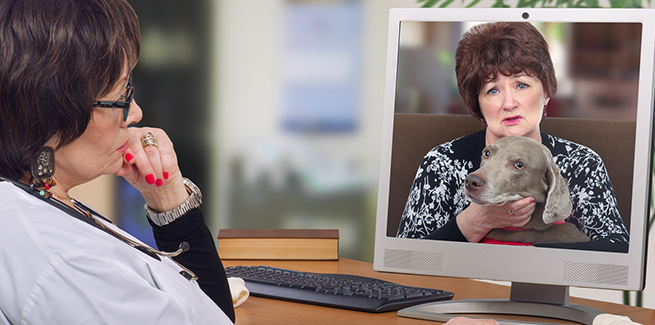Upcoming Oregon vote could change the way you practice telemedicine

A controversial proposed amendment to Oregon’s Veterinary Practice Act may have ripple effects that could change the way veterinarians nationwide practice telemedicine (also known as connected care) in years to come.
It all hinges on how you define the veterinarian-client-patient relationship (VCPR). Or rather, how you establish it. Traditionally, the profession has held that it’s necessary to establish a VCPR in person because animals can’t tell doctors how they feel.
The problem is, the Oregon Veterinary Medical Examining Board (OVMEB), in their proposed amendment, doesn’t define it, not really.
The amendment would allow veterinarians to treat pets via online consultation without the need to have first examined the patient physically, so long as the pet has been examined by a veterinarian within the past year.
From the proposed standards: A veterinarian may practice veterinary telemedicine (VTM) “if they have not physically examined the animal within the last year only under the following circumstances:
- The veterinarian has reviewed the records of another licensed veterinarian who has seen the animal within the previous year, and
- Only if it is possible to make a diagnosis and create a treatment plan without a physical examination.”
At the root of the controversy are two conflicting telemedicine models: the American Veterinary Medical Association’s (AVMA) telemedicine policy (which AAHA supports) and the American Association of Veterinary State Boards’ (AAVSB) “Guidelines for Telehealth.” The OVMEB based their proposed amendment the AAVSB model.
The AVMA’s policy, released last July, states: “The AVMA believes that veterinary telemedicine should only be conducted within an existing veterinarian-client-patient relationship (VCPR), with the exception for advice given in an emergency until that patient can be seen by a veterinarian.”
Moreover, Lori M. Teller, DVM, DABVP, an associate professor of telehealth in the College of Veterinary Medicine and Biomedical Sciences, Texas A&M University, and vice chair of the AVMA board of directors, told NEWStat that, according to the AVMA guidelines, “The VCPR cannot be established by telephonic or electronic means.”
In contrast, the AAVSB’s “Guidelines for Telehealth,” revised in 2018, allow veterinarians to establish a VCPR remotely, if only by not explicitly discouraging it: “The veterinarian must employ sound professional judgment to determine whether using telehealth is suitable.”
NEWStat asked AAVSB Executive Director Jim Penrod, CAE, FASLA, for clarification. He said that the AAVSB model “would allow a veterinarian to establish a VCPR remotely” if they know the animal well enough to make a general or preliminary diagnosis of their medical condition. Furthermore, he said that the AAVSB “recommends that each jurisdiction promulgate appropriate regulations defining how to establish sufficient knowledge” of the patient.
In other words, it’s up to individual AAVSB member boards such as Oregon’s to define for themselves what constitutes a VCPR when practicing telemedicine.
And that could be a problem.
Teller said that “the OVMEB proposal goes beyond the AAVSB recommended guidelines. [It] removes explicit language requiring licensure in [Oregon] and is vague about licensure requirements in general.” Teller added that the OVMEB proposal held several potential dangers, including lack of provisions for data security and client confidentiality as well as “injudicious use of antimicrobials or controlled substances.”
In general, Teller said, “the OVMEB proposal appears to be too loosely written.”
Glenn Kolb, executive director of the Oregon Veterinary Medical Association (OVMA), which opposes the proposed amendment, told NEWStat, “the debate isn’t about telemedicine per se, but rather about a significant redefinition of the VCPR.”
“AAVSB leaves it to the states to define the criteria for the VCPR,” Kolb said. “[OVMA supports] the AVMA policy, which reiterates the need for the traditional VCPR, including the hands-on exam, especially when the sole purpose is to diagnose and treat a patient.”
OVMEB Executive Director Lori Makinen declined to comment on the issue at this time, but said, “The board will review all public comments received at its next meeting and consider whether to move forward with the proposed amendments.”
The board meets next on February 8.
Photo credit: © iStock/verbaska_studio



